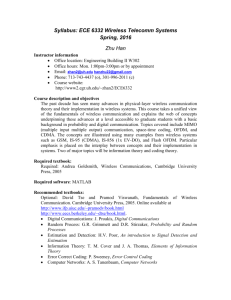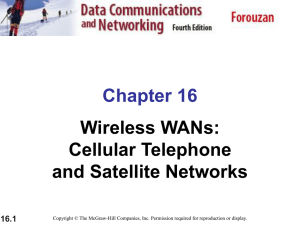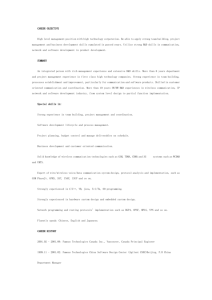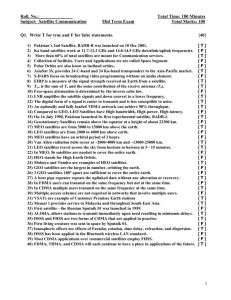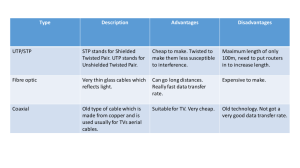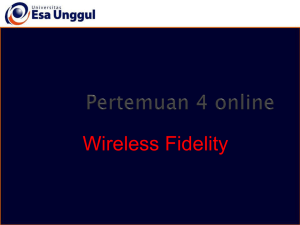Week 3 - DePaul University
advertisement
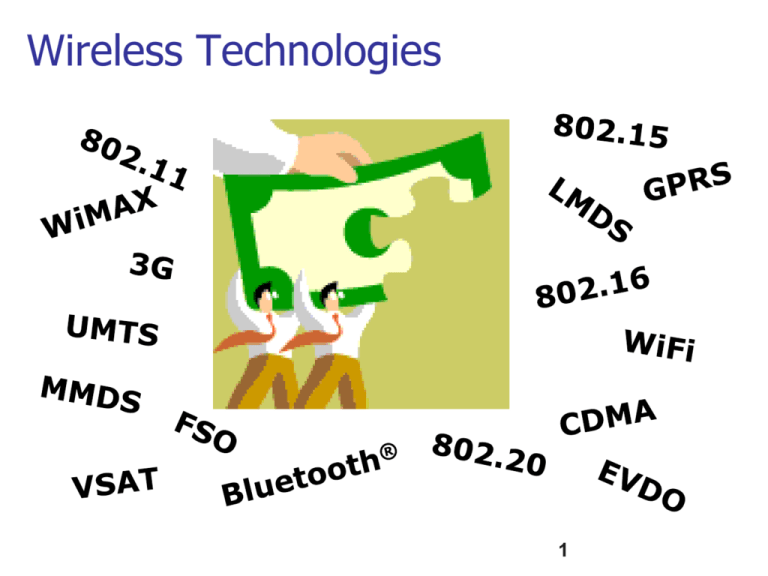
Wireless Technologies 1 Wireless LANs 14.2 We’ll start first with wireless LANs, then move on to Bluetooth, followed by wireless WANs Note A BSS without an AP is called an ad hoc network; a BSS with an AP is called an infrastructure network. 14.3 Figure 14.1 Basic service sets (BSSs) 14.4 Figure 14.2 Extended service sets (ESSs) 14.5 WLAN Standards 802.11 Release Freq Typ Throughput Max Net Bitrate ---- 1997 2.4 GHz 0.9 Mbps 2 IR/FHSS/DSSS a 2003 5 23 54 OFDM b 1999 2.4 4.3 11 DSSS g 2003 2.4 19 54 OFDM n 2009 2.4 / 5 74 600 OFDM More on each of these a little later. 14.6 Mod WLAN Performance (line rate) WLAN Performance 60 Throughput (Mbps) 50 40 802.11g 30 20 802.11a 10 802.11b 0 0 100 200 300 400 Distance (ft) Data Source: Cisco Networking Professional On-Line Live Tech Talk 7 500 Creating WLAN Connections An Access Point (AP) broadcasts is SSID (service set identifier) roughly every 100 ms and at 1 Mbps (to accommodate the slowest client) The Wi-Fi standard leaves connection criteria open to the client The Wi-Fi spectrum is divided into a fixed number of channels 14.8 11 in North America 13 in most of Europe and China 14 in Japan Creating WLAN Connections 14.9 But not all channels are used due to the concern of overlapping frequencies In North America, only channels 1, 6 and 11 are recommended for 802.11b and g. IEEE 802.11a has 42 channels, of which only 24 are used in North America, from which only about 12 are used to reduce overlapping frequencies Figure 14.3 MAC layers in IEEE 802.11 standard FHSS - frequency hopping spread spectrum DSSS - direct sequence spread spectrum OFDM - orthogonal frequency division multiplexing 14.10 Figure 14.4 CSMA/CA flowchart DIFS: distributed interframe space SIFS: short interframe space 14.11 Figure 14.5 CSMA/CA and NAV (Network Allocation Vector) When a station sends its RTS, it includes a time of how long it needs the medium. Other stations then set their NAV timer to this time so they don’t transmit. 14.12 DIFS: Distributed interframe space; SIFS: short interframe space Figure 14.6 Example of repetition interval 14.13 Figure 14.7 Frame format FC: Frame Control D: duration of the transmission that is used to set the value of NAV SC: sequence control: defines the sequence number of the frame to be used in flow control 14.14 Table 14.1 Subfields in FC field 14.15 Figure 14.8 Control frames FC: Frame Control D: duration of the transmission that is used to set the value of NAV 14.16 Frame Types Three types of frames: 1. Management - used for initial communication between stations and access points 2. Control - used for accessing the channel (RTS) and acknowledging frames (CTS or ACK) (See Figure 15-10). 3. Data - used for carrying data and control information 14.17 Table 14.2 Values of subfields in control frames 14.18 Table 14.3 Addresses 14.19 Case – 00 (ad hoc) 11-22-33-01-01-01 11-22-33-02-02-02 A1: 11-22-33-01-01-01 DA A2: 11-22-33-02-02-02 SA A3: BSS ID A4: not used 20 Case – 01 (wired to wireless) wireless 802.11 11-22-33-01-01-01 wired 802.3 99-88-77-09-09-09 A1 (RA): 11-22-33-01-01-01 A2 (TA): 99-88-77-09-09-09 11-22-33-02-02-02 DA: 11-22-33-01-01-01 SA: 11-22-33-02-02-02 A3 (SA): 11-22-33-02-02-02 A4: not used RA: Wireless Receiver Address TA: Wireless Transmitter Address 21 Case – 10 (wireless to wired) wired 802.3 wireless 802.11 11-22-33-01-01-01 99-88-77-09-09-09 11-22-33-02-02-02 A1 (RA): 99-88-77-09-09-09 DA: 11-22-33-02-02-02 A2 (TA): 11-22-33-01-01-01 SA: 11-22-33-01-01-01 A3 (DA): 11-22-33-02-02-02 A4: not used RA: Wireless Receiver Address TA: Wireless Transmitter Address 22 Case – 11 (via wireless) wired 802.3 11-22-33-01-01-01 wireless 802.11 99-88-77-09-09-09 DA: 11-22-33-02-02-02 SA: 11-22-33-01-01-01 wired 802.3 99-88-77-08-08-08 11-22-33-02-02-02 A1 (RA): 99-88-77-08-08-08 DA: 11-22-33-02-02-02 A2 (TA): 99-88-77-09-09-09 SA: 11-22-33-01-01-01 A3 (DA): 11-22-33-02-02-02 A4 (SA): 11-22-33-01-01-01 23 Figure 14.10 Hidden station problem 14.24 Note The CTS frame in CSMA/CA handshake can prevent collision from a hidden station. 14.25 Wireless Bridge Building A Ethernet Backbone Wireless Bridge Building B Ethernet Backbone Case 11 Wireless Bridge 26 Wireless Repeater LAN Backbone Case 11 Wireless repeater Case 10 Case 01 27 Figure 14.11 Use of handshaking to prevent hidden station problem Station C doesn’t hear RTS from B, but it does hear CTS from A, so it knows something is up. 14.28 Figure 14.12 Exposed station problem C wants to send to D, but hears A talking to B, so assumes the medium is (incorrectly) busy. 14.29 Figure 14.13 Use of handshaking in exposed station problem Looking for a CTS handshake does not work in this case. 14.30 Table 14.4 Physical layers 14.31 Figure 14.14 Industrial, scientific, and medical (ISM) band 14.32 IEEE 802.11b First modification to the 802.11 standard HR-DSSS (High Rate DSSS) 2.4 GHz (ISM band) up to 14 (5MHz per channel) Non-overlapping channel: 3 Speed: 1 (Baker), 2 (Baker), 5.5 (CCK), and 11M bps (CCK) Distance: 300 ft 2.412 – 2.484 Channel: Baker code (chipping code) and Complementary Code Keying (CCK) In practice: ~100 ft Interference: cordless phone, microwave oven 33 IEEE 802.11a Higher speed protocol 5 GHz (UNII band) 5.15 – 5.825 GHz Spread Spectrum Transmission: orthogonal frequency division multiplexing (OFDM) Data rate: 6, 9, 12, 18, 24, 36, 48, or 54Mbps Mbps Distance: ~60 ft Less interference than 802.11b More users per AP than 802.11b More non-overlapping channels (8/12 vs. 3) UNII: unlicensed national information infrastructure 34 IEEE 802.11g Two competing standards to improve 802.11b Frequency: 2.412 – 2.484G Hz (same as 802.11b) Speed: up to 54M bps Distance: comparable to 802.11b Shorter distance at higher rate Backward compatible with 802.11b CCK => PBCC, 22M bps (This is known as 802.11b+) DSSS => OFDM, 54M Caveat: so is the performance. Spread Spectrum Transmission: OFDM (same as 802.11a) PBCC: Packet Binary Convolution Code 35 WLAN Performance 802.11b 802.11a 802.11g Link Rate (max) UDP 11M bps 54M bps 54M bps 7.1M bps 30.5M bps 30.5M bps TCP 5.9M bps 24.4M bps 24.4M bps The test was conducted in a lab environment, and the distance is expected to be less than 10m. Ref. “WLAN Testing with IXIA IxChariot,” IXIA White Paper 36 802.11n It is a standard – finally, but many pre-n products Over-the-air (OTA) data rate: 500 Mbps MAC performance: 200 Mbps Improved Channel bandwidth: 20MHz => 40MHz Physical layer: Multiple-Input-Multiple-Output (MIMO) An improvement over OFDM Backward compatibility: 802.11g/a (2.4GHz, and 5.0GHz) Distance/coverage: somewhat shorter than 802.11g/a 37 MIMO 38 14-2 BLUETOOTH Bluetooth is a wireless LAN technology designed to connect devices of different functions such as telephones, notebooks, computers, cameras, printers, coffee makers, and so on. A Bluetooth LAN is an ad hoc network, which means that the network is formed spontaneously. Topics discussed in this section: Architecture Bluetooth Layers Baseband Layer L2CAP 14.39 Figure 15.17 Bluetooth details Radio layer - roughly equivalent to physical layer. Uses 2.4 GHz ISM divided into 79 channels of 1 MHz each. Uses FHSS: 1600 hops/sec, so each frequency lasts for only 625 microseconds (1/1600). This is the dwell time. Basic rate (BR) uses Gaussian FSK at 1 Mbps, extended data rate (EDR) uses pi/4-DQPSK for 2 Mbps and 8DPSK for 3 Mbps Baseband layer - roughly equivalent to MAC sublayer and uses TDD-TDMA (time-division duplexing TDMA). Similar to walkie-talkies using different carrier frequencies. 14.40 Figure 15.17 Bluetooth details Primary-secondary architecture with up to 7 slaves in a piconet. All devices share the primary’s clock. Packet exchange based on two ticks of a 312.5 microsec clock. 14.41 Figure 14.19 Piconet 14.42 Figure 14.20 Scatternet 14.43 Figure 14.21 Bluetooth stack Windows CE 5.0 Required: L2CAP, SDP, LMP L2CAP: Logical Link Control and Adaptation Protocol – used to multiplex multiple logical connections between two devices SDP: Service Discovery Protocol – allows a device to discover services offered by other devices LMP: Link Management Protocol – used to manage the radio link between 2 devices 14.44 Figure 14.22 Single-secondary communication Note: primary transmits in even slots, secondary in odd 14.45 Figure 14.23 Multiple-secondary communication 14.46 Primary switches between secondaries in round-robin fashion Figure 14.24 Frame format types Access code: 72-bit field normally contains sync bits and ID of the primary to distinguish the frame of one piconet from another Address: up to 7 secondaries; 0 means broadcast Type: defines the type of data coming from the upper layer F: flow control (1 indicates buffer full); A: ACK (bluetooth uses stop and wait) S: sequence number for stop and wait 14.47 Figure 14.25 L2CAP data packet format L2CAP layer roughly equivalent to LLC layer in LANs Length: length of data coming from upper layers Channel ID: defines a unique ID for the virtual channel created at this level 14.48 Figure 16.1 16.49 Cellular system Figure 16.2 16.50 Frequency reuse patterns 16.51 16.52 1G 2G GSM AMPS D-AMPS IS-136 CDMA IS-95 iDEN Nextel 2.5G 2.75G GPRS 30-50 kbps 3G UMTS Wideband-CDMA Wireless-CDMA 384kbps; AT&T, T-Mobile EDGE 75-135kbps iPhone (1st generation) 1xRTT CDMA2000 1x IS-2000 144 kbps 3.5G CDMA2000 EV-DO 1xEV EV IS-856 2.5 Mbps down 154 kbps up Verizon, Sprint HSPA LTE? High speed packet access 400-700kbps (or 3G ?) Long-term Evolution 3-5 Mbps CDMA2000 EV-DV Dead? 3.1 Mbps down 1.8 Mbps up UMB ?? UltraMobile Broadband WiMax?? EV-DO Rev.A Up to 3.1Mbps AT&T, Verizon, and Alltel now support LTE. What about WiMax for 4G? 16.53 4G Wi-Fi??? Note AMPS is an analog cellular phone system using FDMA. 16.54 Figure 16.3 16.55 Cellular bands for AMPS Figure 16.4 AMPS reverse communication band 16.56 Figure 16.5 Second-generation cellular phone systems 16.57 Figure 16.6 D-AMPS 16.58 Note D-AMPS, or IS-136, is a digital cellular phone system using TDMA and FDMA. 16.59 Figure 16.7 GSM bands 16.60 Figure 16.8 GSM GSM uses TDMA and FDMA concepts GMSK (Gaussian minimum shift keying): a form of FSK used in European systems 16.61 Figure 16.9 GSM Multiframe components Lots of overhead!! 16.62 Figure 16.10 IS-95 CDMA forward (base to mobile) transmission 19.2 ksps = 19.2 kilosignals per second 19.2 ksps signal converted to 64-chip sequence, giving 1.228 Mcps (mega-chips) ESN: electronic serial number of handset ESN is used to generate 2^42 pseudorandom chips, each having 42 bits. Decimator chooses 1 bit out of the 64, and then is scrambled with digitized voice to create privacy. 16.63 Figure 16.11 IS-95 CDMA reverse (mobile to base) transmission Each 6 symbols are used to index into a 64x64 Walsh matrix; thus each 6-symbol chunk is replaced (not multiplied as it would be with CDMA) with a 64-chip code. A 42-bit unique code is generated by the mobile hand set and combined with the 307.2 kcps signal creating a 1.228 Mcps signal. Note: CDMA not used here because no way of syncing all mobile devices together! Frequency reuse is 1, since neighboring channels cannot interfere with CDMA or DSSS transmission. 16.64 Note In CDMA, one channel carries all transmissions simultaneously. 12.65 Figure 12.23 Simple idea of communication with code 12.66 Figure 12.24 Chip sequences 12.67 Figure 12.25 Data representation in CDMA 12.68 Figure 12.26 Sharing channel in CDMA 12.69 Figure 12.27 Digital signal created by four stations in CDMA 12.70 Figure 12.28 Decoding of the composite signal for one in CDMA 12.71 Figure 12.29 General rule and examples of creating Walsh tables 12.72 Note The number of sequences in a Walsh table needs to be N = 2m. 12.73 Example 12.6 Find the chips for a network with a. Two stations b. Four stations Solution We can use the rows of W2 and W4 in Figure 12.29: a. For a two-station network, we have [+1 +1] and [+1 −1]. b. For a four-station network we have [+1 +1 +1 +1], [+1 −1 +1 −1], [+1 +1 −1 −1], and [+1 −1 −1 +1]. 12.74 Example 12.7 What is the number of sequences if we have 90 stations in our network? Solution The number of sequences needs to be 2m. We need to choose m = 7 and N = 27 or 128. We can then use 90 of the sequences as the chips. 12.75 Example 12.8 Prove that a receiving station can get the data sent by a specific sender if it multiplies the entire data on the channel by the sender’s chip code and then divides it by the number of stations. Solution Let us prove this for the first station, using our previous four-station example. We can say that the data on the channel D = (d1 ⋅ c1 + d2 ⋅ c2 + d3 ⋅ c3 + d4 ⋅ c4). The receiver which wants to get the data sent by station 1 multiplies these data by c1. 12.76 Example 12.8 (continued) When we divide the result by N, we get d1 . 12.77 2.5 Generation iDEN iDEN (Integrated Dispatch Enhanced Network) • Functionally the same as MIRS (Motorola Integrated Radio System) • A high-capacity digital trunked radio system providing integrated voice and data services to its users • Used by Nextel Communications 16.78 2.5 Generation GPRS GPRS (General Packet Radio Service) • The 2.5G version of GSM • Theoretically allows each user access to 8 GSM data channels at once, boosting data transfer speeds to more than 100 Kbps (30 Kbps in the real world since it only uses 2 GSM channels) • AT&T Wireless, Cingular, T-Mobile 16.79 2.5 Generation 1xRTT 1xRTT (CDMA2000) 1x Radio Transmission Technology • The 2.5G backwards compatible replacement for CDMA • 1xRTT will replace CDMA and iDEN • 1x means that it requires only the same amount of spectrum as 2G networks based on CDMA (IS-95) •Sprint and Verizon 16.80 3rd Generation UMTS UMTS (Universal Mobile Telecommunications System) • Also called Wideband CDMA • The 3G version of GPRS • UMTS is not backward compatible with GSM, so first UMTS phones will have to be dual-mode • Based on TDMA, same as D-AMPS and GSM 16.81 3rd Generation 1xEV 1xEV (1x Enhanced Version) • The 3G replacement for 1xRTT • Will come in two flavors • 1xEV-DO for data only • 1xEV-DV for data and voice 16.82 EDGE EDGE (Enhanced Data rates for Global Evolution) • Further upgrade to GSM • Possible 3G (no – 2.75G) replacement for GPRS • Uses improved modulation to triple the data rate where reception is clear 16.83 LTE LTE (3GPP LTE – Long Term Evolution) • 3G upgrade to UMTS • 3GPP – third generation partnership project • LTE actually an architecture – contains EPS (evolved packet system), EUTRAN (evolved UTRAN), and EPC (evolved packet core) •OFDM, QPSK, 16QAM, 64QAM, MIMO 16.84 16-2 SATELLITE NETWORKS A satellite network is a combination of nodes, some of which are satellites, that provides communication from one point on the Earth to another. A node in the network can be a satellite, an Earth station, or an enduser terminal or telephone. Topics discussed in this section: Orbits Footprint Three Categories of Satellites GEO Satellites MEO Satellites LEO Satellites 16.85 Figure 16.13 16.86 Satellite orbits Example 16.1 What is the period of the Moon, according to Kepler’s law? Here C is a constant approximately equal to 1/100. The period is in seconds and the distance in kilometers. 16.87 Example 16.1 (continued) Solution The Moon is located approximately 384,000 km above the Earth. The radius of the Earth is 6378 km. Applying the formula, we get. 16.88 Example 16.2 According to Kepler’s law, what is the period of a satellite that is located at an orbit approximately 35,786 km above the Earth? Solution Applying the formula, we get 16.89 Example 16.2 (continued) This means that a satellite located at 35,786 km has a period of 24 h, which is the same as the rotation period of the Earth. A satellite like this is said to be stationary to the Earth. The orbit, as we will see, is called a geosynchronous orbit. 16.90 Table 16.1 Satellite frequency bands L: GPS S: weather, NASA, Sirius/XM satellite radio C: open satellite communications Ku: popular with remote locations transmitting back to TV studio Ka: communications satellites 16.91 Figure 16.15 16.92 Satellite orbit altitudes Figure 16.16 Satellites in geostationary orbit Rotate with the earth, usually over equator; 1/3 earth coverage 16.93 Figure 16.16 Example GEO satellite – Weather Weather satellites can watch more than weather. Can also observe city lights, fires, pollution effects, auroras, sand and dust storms, snow cover, energy flows, volcano output, etc. Can observe both visible spectrum and infrared spectrum The U.S. has two geostationary weather birds: GOES-11 and GOES-12. GOES-12, or GOES-EAST, over the Mississippi River, covers most of the U.S. weather. GOES-11 covers the eastern Pacific Ocean. 16.94 Figure 16.17 Orbits for typical LEO and MEO systems, e.g. GPS LEO and MEO satellites need to move or their orbits will decay; thus need >1 satellite to maintain connection. 16.95 Figure 16.18 Trilateration In a 2D plane, two reference points yields 2 intersections, three reference points yield 1 intersection In a 3D plane, need four reference points to yield 1 intersection 16.96 Figure 16.19 LEO satellite systems UML: user mobile link GWL: gateway link ISL: intersatellite link 16.97 Figure 16.20 LEO example: Iridium constellation Designed by Motorola during the 1990s, went bankrupt in 1999. What cost $5 billion was sold for $25 million. 66 active satellites with a few spares at a height of 781 km (485 miles). Sold to Iridium Communications Inc. Iridium plans to send up 66 new satellites and 6 spares starting in 2015, called IridiumNext. Data and voice. 16.98 Figure 16.20 MEO example: GPS (global positioning system) GPS was established in 1973 by U.S. and consisted of 24 satellites (now ~32). Dual-use system – military and civilian. Civilian side used by commerce, science, banking, mobile phones, farmers, surveyors, power grids, you and me. GPS can provide absolute location, relative movement, and time transfer. Inducted into Space Foundation Space Technology Hall of Fame in 1998. Three satellites gives you 2 points, but you can choose the one on the ground; 4 gives you 1 point and overcomes clock errors; usually see at least 6; often see 8-10 16.99 Figure 16.20 MEO example: GPS (global positioning system) Each satellite continually transmits messages that include (1) the time the message was transmitted, (2) precise orbital information (the ephemeris), and (3) general system health and rough orbits of all GPS satellites (the almanac) Receiver takes messages, determines the transit time of each message and computes the distances to each satellite. These distances along with satellites’ locations are use in determining receiver’s location (trilateration). (See Wikipedia GPS for cool image of satellite visibility.) 16.100 Figure 16.20 MEO example: GPS (global positioning system) GPS consists of 3 segments (1) Space segment – the space vehicles at ~20,200km (2) Control segment – a master control station, an alternate master control station, four dedicated ground antennas, and six dedicated monitor stations (3) User segment – you and me All satellites broadcast at two frequencies: 1.57542 GHz and 1.2276 GHz using CDMA spread-spectrum technology What will you create? 16.101


